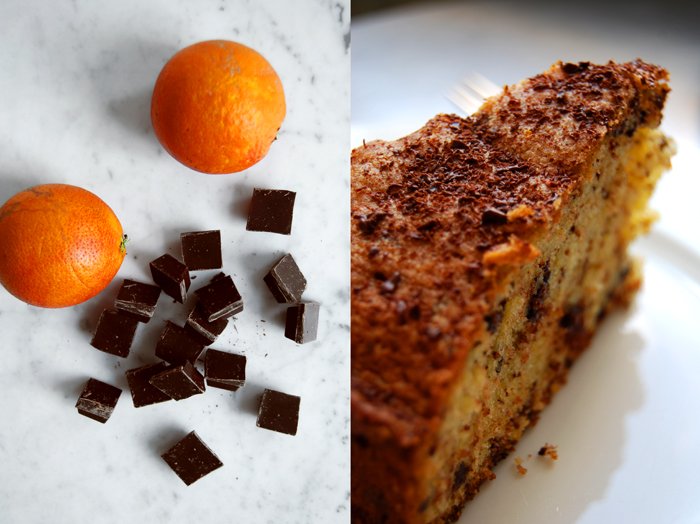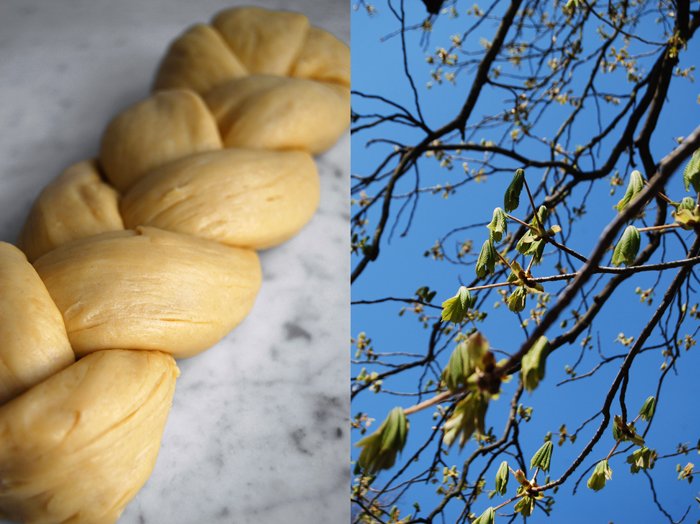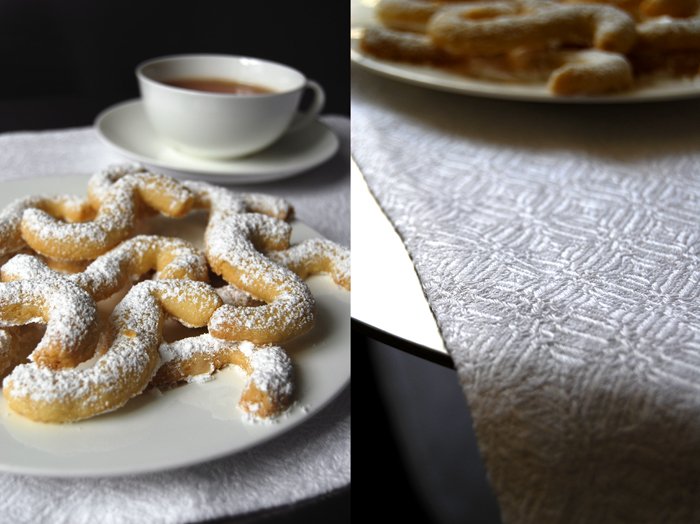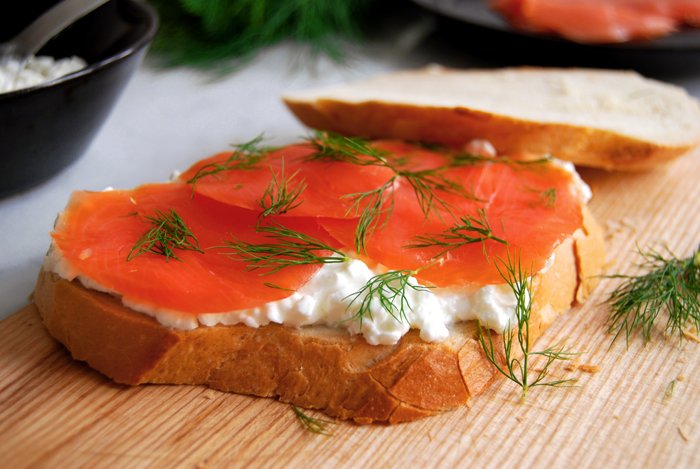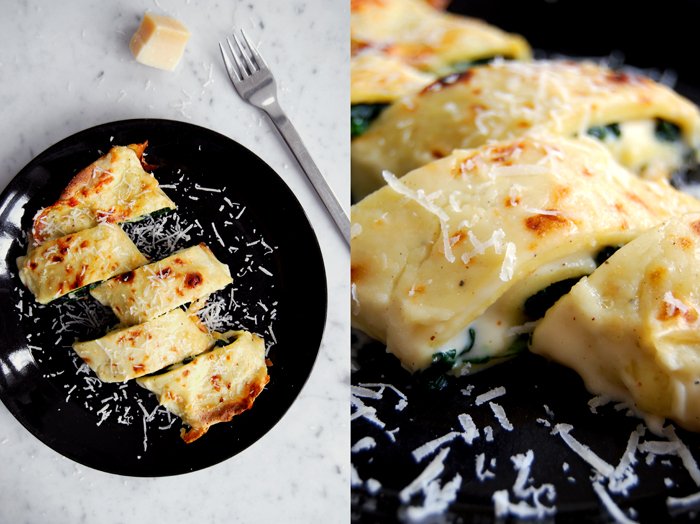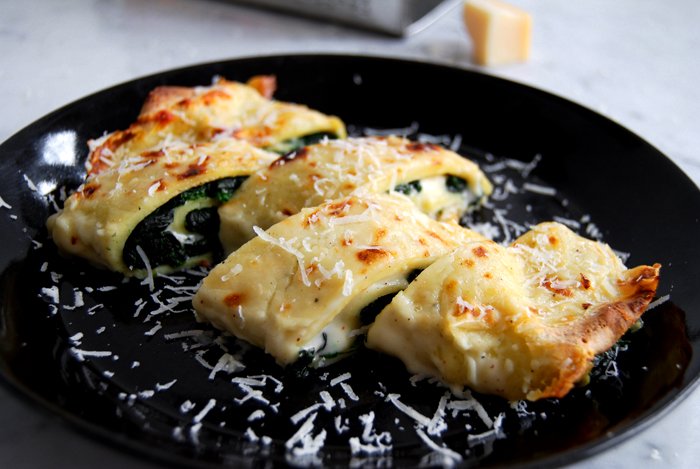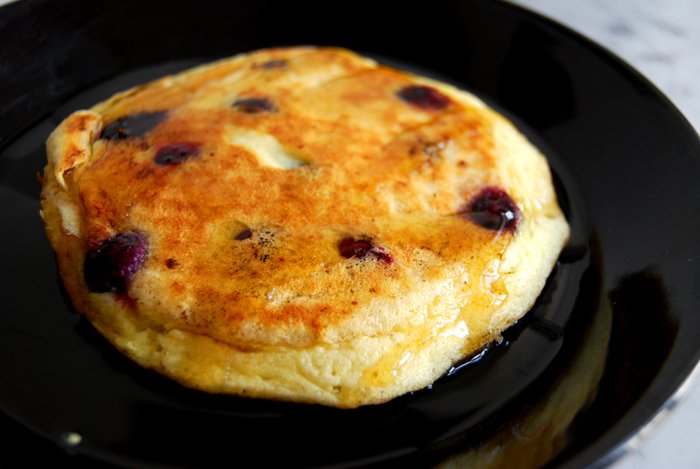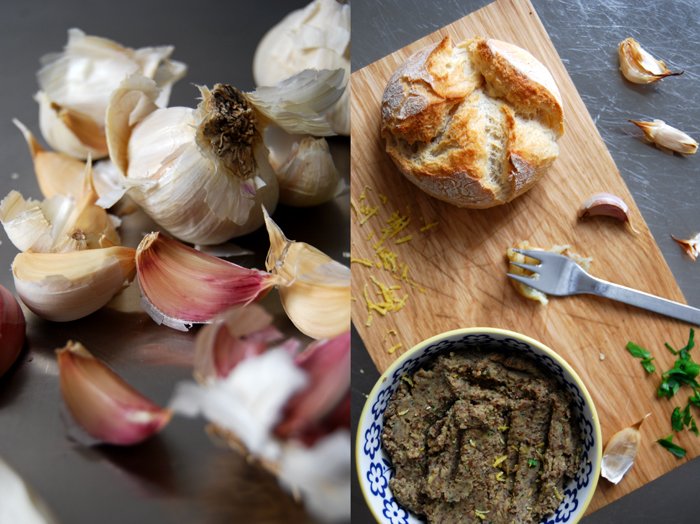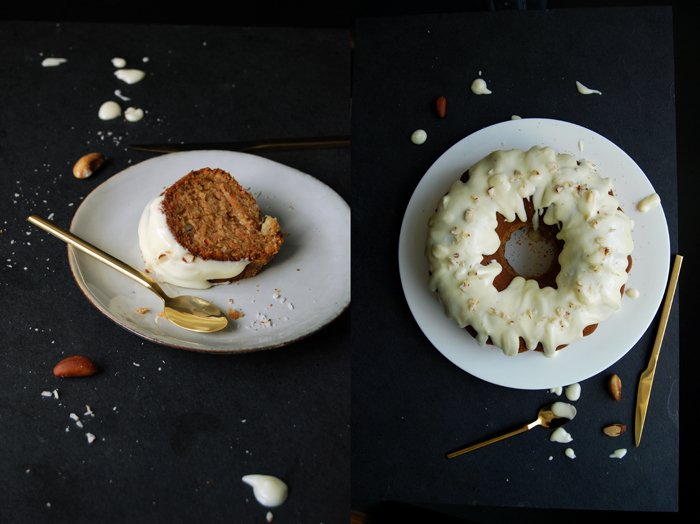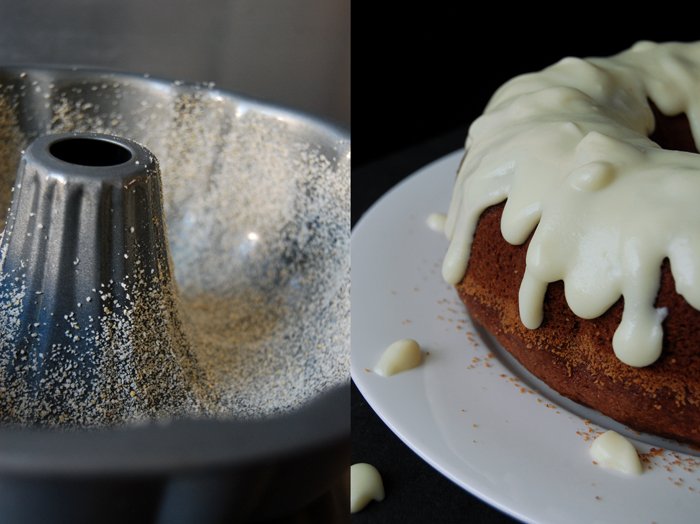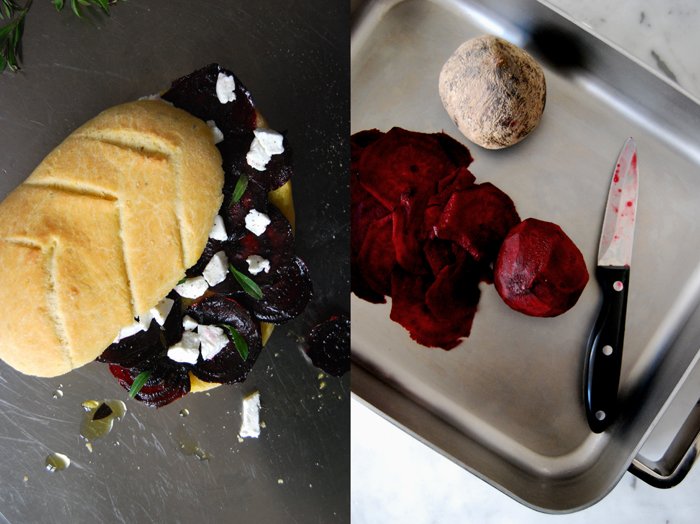Bittersweet Chocolate and Orange Sponge Cake
Last week I wrote about one of my numerous phone calls with my Maltese granny who is actually my boyfriend's granny but over the years, after so many stays on her home island and through our shared passion for food she "adopted" me. That's how it feels, she became my granny. In our last conversation she gave me a wonderful recipe for the Maltese tea time cookies with vermouth and she also mentioned a cake made with bittersweet chocolate and orange (juice and zest). I love this combination but my boyfriend isn't so fond of it and I didn't want to end up eating a whole cake on my own. But she insisted on giving it a try, she knows her grandson after all, and she was right!
We both agreed that this cake is amazing, simple but so aromatic. The texture is very spongy and on top it has a fine sugary crust, a bit flaky. I sprinkled it with some more chocolate when the top was still a bit warm and it melted into the crust. Granny Edith was right, I didn't have to eat the cake on my own and it didn't even last for 2 days!
Bittersweet Chocolate and Orange Sponge Cake
For a 20cm / 8″ cake pan you need
butter 180g / 6.5 ounces
granulated sugar 210g / 7.5 ounces
plain flour 180g / 6.5 ounces
baking powder 2 teaspoons
a pinch of salt
organic eggs 3
orange juice 2 tablespoons
orange zest 1 1/2 tablespoons
bittersweet chocolate, chopped coarsely, 100g / 3.5 ounces plus 1 tablespoon finely grated for the topping
Set the oven to 175°C / 350°F (fan-assisted oven) and butter the cake pan.
Mix the butter with the sugar and orange zest till fluffy. Add the eggs, one at a time and mix well for a couple minutes. Add the flour, baking powder, salt and orange juice and mix quickly until everything is combined. Stir in the chopped chocolate and scrape the dough into the prepared pan. Bake for 40 minutes or until golden brown. Check with a skewer, it should come out clean. Let the cake cool for 5 minutes and sprinkle with finely grated chocolate.
Challah - Sweet and Fluffy Braided Yeast Bread
As passionate as I am about my dinner, I feel the same about breakfast which is quite late in my case. I always start the day with a cup of green tea with freshly squeezed lemon as I don't like to eat early in the morning but then after a couple hours my body needs some energy which I gladly deliver. Bread, fresh vegetables and fruit, my coffee of course, and some cheese. To me, it's all about bread, dark or white, buns, croissant, during the week it's a dense spelt loaf from my bakery most of the time but then on the weekend I love to bake my own bread. It's the most relaxing and delicious way to end the week!
Where I grew up, I used to buy a brioche like loaf of bread, fluffy and sweet, a bit dark on the outside, sometimes made with raisons, it's called Stuten or Blatz. It's baked square shaped and best when cut into thick slices, spread with butter or, one of my favourites, with liver pâté. I never managed to bake a Stuten as good as the one I bought from my hometown's bakery which unfortunately doesn't even exist anymore. I'm still working on it!
For now, I enjoy a similar bread, in a different shape and made with a slightly different dough. The wonderful Challah! The braided yeast bread is just as sweet and fluffy, I eat it either with butter or liver pâté, or with one of my homemade jams, like the blood orange or tangerine marmalade.
The trees and flowers around have been bursting in the past days, I had to catch these moments and share it as I enjoy this beauty as much as a fresh and warm loaf out of my oven!
Sweet and Braided Yeast Bread
For one braided loaf of bread you need
plain flour 500g / 1 pound
dry yeast 1 sachet (7g / 1/4 ounce)
granulated sugar 60g / 2 ounces
salt 1/2 teaspoon
butter, melted, 100g / 3.5 ounces
milk, lukewarm, 150ml
organic eggs 2
pearl sugar, for sprinkling
organic egg yolk 1, for the glaze
milk 1 tablespoon, for the glaze
Combine the dry ingredients. Mix the hot melted butter with the cold milk and the 2 eggs, this way the liquid mixture will have the right lukewarm temperature (check with your finger). Mix the dry and the liquid mixture with your dough hooks for 5 minutes until well combined. Continue kneading with your hands for a few minutes until you have an elastic dough ball. Put the dough back into the bowl and cover with a tea towel. Let the dough rise in a 35°C / 95°F warm oven for 70 minutes (I tried it for 60 minutes but the last 10 minutes make a big change). This works really well but make sure that your oven is set to top/ bottom heat and not to fan.
Take the dough out, punch it down and knead for 1 minute. Divide it into 3 pieces and roll them into long sausage shapes. Lay the ends of the rolls on top of each and start to braid them tightly. Bend both ends under the loaf and put on a baking sheet lined with parchment paper. Let it rise for 30 minutes, covered with a tea towel, in the warm oven.
Set your oven to 200°C / 390°F (top / bottom heat).
Whisk the egg yolk and milk for the glaze, brush the bread, sprinkle with pearl sugar and bake in the oven for 10 minutes before you turn it down to 180°C / 355°F and bake for another 15 minutes until golden brown.
A Bavarian Sandwich with Obatzda and spicy Radish
In a Bavarian beer garden, you can be sure you will find plenty of beer, sausages and at vesper time a traditional delicacy which is served with bread, I'm talking about Obatzda also known as Obatzter meaning mashed. Drinking beer in Bavaria demands strong physical condition as it's served in a 1 liter mug, the "mass". You may imagine that it's quite helpful to have some rich food on the side when drinking such quantities (obviously people don't stop after their first "mass" of beer). Obatzda is one of them and it's offered in huge varieties. It's basically a cream made of aged cheese leftovers often mixed with either herbs or spices like hot paprika powder or caraway seeds, onion, garlic, a shot of beer, horseradish, butter, cream cheese, I could continue endlessly. It is, again one of those dishes that evolved in each region with each personal preference and local tradition.
My Obatzda is green, it's based on rucola and a middle-aged camembert and cream cheese. I added some radish and watercress to bring out the rucola's mild spiciness next to the rich and tangy cheese. White bread wouldn't have managed to keep up with these strong flavours, I used dark spelt bread. This sandwich needs a dense and juicy texture, strong bread with a nice crust. What is great about this dip is that you can really play around with the leftovers of your fridge. Spring onions, dried tomatoes, olives, all the ingredients mentioned above, you can create your own Obatzda after your own preferences. After your selection is made, mix everything in a blender or mash with a fork and spread on a slice of bread, a thick layer, this is a luscious Bavarian sandwich after all!
For a little bowl of Obatzda, I mixed 30g / 1 ounce of rucola with 50g / 2 ounces of aged camembert, 150g / 5.5 ounces of cream cheese and 1 tablespoon of heavy cream, seasoned with salt and pepper to taste. Depending on the camembert's age and tanginess you might need more or less cream cheese, the same with salt. When the dip is spread on a slice of bread, sprinkle with thin slices of radish and some watercress.
Essijiet - Maltese Tea Time Cookies with a shot of Vermouth
When I'm on the phone or video chat with our family in Malta, you can be sure it will go on for hours, it will involve many people, coming and going, lots of laughing and very often the exchange of recipes. Especially when I talk to Granny Edith who has been cooking and baking all her life, so you can imagine her large recipe collection, influenced by her mother, grandmother and all the close relatives and friends which are quite numerous in a Maltese family. I found so many traditional dishes in her collection, true treasures! Like everybody else in the family, I love to sit with Edith at her kitchen table in her beautiful old villa in Msida at the sea, talking about life, cooking, men, fashion, the offers at the vegetable man and the butcher, normal daily life, it feels so easy on this island! We enjoy a cup of tea, some sweets from our local confectionary (which is the best in Malta in our opinion) and appreciate every second!
Recently I've been talking to her about baking and she handed some recipes over to me which caught my attention. One is a traditional tea time cookie recipe from her mother-in-law Maria, she used to make them for the family, Edith continued the tradition and now she passes it on to the next generations. It's a very easy cookie recipe, made with so little ingredients that I thought I had left some out when I started preparing the dough. It's just butter, flour, baking powder, salt, sugar and a shot of vermouth making a delicious cookie, fine in taste, buttery and crumbly. I couldn't have asked for more for tea time! The cookies don't really have a proper name apart from the family given one, referring to their shape they are called Essijiet, meaning many "S" in Maltese.
Essijiet - Maltese Tea Time Cookies
For around 60 cookies you need
plain flour 300g / 10.5 ounces
baking powder 1/2 teaspoon
granulated sugar 1 tablespoon
a pinch of salt
butter 200g / 7 ounces
vermouth 2 tablespoons
icing sugar for dusting
Combine the flour with the baking powder, sugar and salt. Cut the butter with a knife into the flour until there are just little pieces of butter left. Continue with your fingers and work the butter into the flour until combined (there shouldn’t be any lumps of butter left). Add the vermouth and continue mixing with the hooks of your mixer until you have a crumbly mixture. Form a ball, wrap in cling film and put in the fridge for an hour or in the freezer for 15 minutes.
Set the oven to 175°C / 350°F and prepare a baking sheet with parchment paper.
Cut thick slices off the dough, make thin rolls and cut into 12cm / 5" pieces. Form the cookies into an S-shape and bake for 9 minutes or until lightly golden (they stay light in colour). Let them cool for a couple minutes and dust with icing sugar.
Serrano, Mozzarella di Bufala and Pesto Focaccia
When my brother in law stayed with us 2 weeks ago I asked him about his favourite sandwich. I often ask friends as it's a great inspiration for my Sandwich Wednesday but it's also interesting to find out about different sandwich preferences. It may sound silly, but a favourite sandwich says a lot about a person! He answered quick and with a smile on his face, Serrano prosciutto, mozzarella and pesto sandwich with toasted pine nuts on top. He is a true gourmet, I know and appreciate his sense for fine food, so I didn't wait too long to get all the ingredients, I was curious!
I chose an Italian Focaccia bun from my bakery for this sandwich, juicy and baked with lots of olive oil and sprinkled with sea salt. I bought 8 thin slices of Serrano and one Mozzarella di Bufala of 125g / 4.5 ounces which I cut into thick slices. I made a quick pesto, a handful of basil leaves chopped finely with a big knife, mixed with a tablespoon of good olive oil and some salt. While I cut the 2 buns open and filled them with the prosciutto and mozzarella, I toasted the pine nuts in a sauce pan without oil on medium heat for a couple minutes until golden. I drizzled the pesto and pine nuts on top, took the first bite and smiled like my brother in law did when he told me about this absolutely delicious sandwich! It's great!
If you would like to share your favourite sandwich with me, just get in touch! I would love to try different sandwiches from all over the world, quick ones, complicated ones, exotic, puristic or sumptuous, whatever your taste buds like! Just get in touch here,
Meike xx
Chicory Boats with Pear Dressing and Pink Peppercorns
Last week I bought some pink peppercorns, the first ones in years. I forgot about them after I used them the last time, I just emptied the jar and it never got refilled. Although the pink berry is the fruit of the Peruvian Pepper Tree it's not related to common pepper, it's just a berry. Nevertheless, I used to love them, on steak, in creamy sauces, and even on desserts. That's actually the reason why I bought them again, in the next few months I want to try out a few sweet combinations. They taste mild, with a flowery aroma, and offer lots of culinary possibilities but first I have to think about a few ideas. For now I'll start with a simple savory dish.
I have some finger food in mind, an easy in between nibble. I take the big leaves of 3 chicory (also known as Belgian endive) and dollop a little of a fruity dressing on top. It's made of 4 heaped tablespoons of yoghurt mixed with 3 teaspoons of tomato paste and 1 crunchy pear, grated without peel and stirred in as well. I season it with salt and black pepper and my pink peppercorns, crushed and sprinkled on top. The pink berries had a tasty return to my kitchen!
My Mother's delicious Tarte Tatin
Tarte Tatin, I know so many people who call this their favourite dessert! Buttery apples fried with lots of sugar until golden brown and caramelised, topped with a crisp shortcrust baked in the oven. It's like a traditional pie, just upside down! There is something very French about it and it's not just the amount of butter and sugar, or its origin. Legend has it that this tarte was first created accidentally by Caroline Tatin. She ran the Hotel Tatin in Lamotte-Beuvron together with her sister Stéphanie. A stressful kitchen moment made her forget about the apples on her cooker, they caramelised and Caroline had an idea. She left them in the pan, put the dough on top and baked the first delicious Tarte Tatin ever. The guests in her hotel were impressed and her signature dish was born!
Now, there are many different ways to bake a Tarte Tatin. I make mine like my mother, with a crisp and buttery shortcrust (it's the one I also use for my Sandwich Cookies). I cut the apples in eight slices each so that they can caramelise evenly on all sides (I find it easier than quarters). I fry them in plenty of butter and sugar, the apples soak up all the syrup and the base stays crisp.
Tarte Tatin
For the tarte you need a 21cm / 8" Tarte Tatin dish or frying pan which is ovenproof.
big sour baking apples, peeled, cored and cut into eight slices each, 4
granulated sugar 90g / 3 ounces
butter 90g / 3 ounces
For the shortcrust
plain flour 130g / 4.5 ounces
butter, cold, 75g / 3 ounces
egg yolk 1
granulated sugar 1 tablespoon
a pinch of salt
cold water 1 1/2 tablespoons
For the shortcrust, combine the flour with the sugar and salt. Cut the butter with a knife into the flour until there are just little pieces of butter left. Continue with your fingers and quickly work the butter into the flour until combined. Add the egg yolk and the water, continue mixing with the hooks of your mixer until you have a crumbly mixture. Form a disc, wrap in cling film and put in the freezer for 10 minutes.
Set the oven to 200°C / 390°F.
In a pan (or Tarte Tatin dish), melt the butter together with the sugar and the apples on high temperature. Let the apples caramelise, watch them and turn gently, mine needed 10 minutes.
Roll out the dough, big enough to cover the pan and lay on top of the apples tucking the edges down the sides. Bake in the oven for 15 minutes or until golden brown. When the tarte is done, place a large heat resistant plate on top and turn the pan carefully upside down, keep in mind that it's very hot!
You can serve the warm Tarte Tatin with whipped cream or vanilla ice cream.
Irish Coffee Muffins
Saint Patrick's Day is close and although it is a religious feast to praise the patron saint of Ireland, it reminds me of a rather profane culinary pleasure, Irish Coffee. It's one of my favourite hot drinks! Sitting at a fireplace, cosy and relaxed, with a glass of warming Irish Coffee in my hands is unbeatable! I like it so much that I decided to put it in my muffins as well.
I mix some Irish whiskey, coffee and cream into the dough to be rewarded with the most delicious and fluffy muffins, but they are for adults only as I also topped them with whiskey infused whipped cream. I wanted strong spirit and coffee flavours and I got it! After cleaning the last drops of dough off the bowl with my fingers I already felt a bit tipsy!
If you like muffins as much as I do you can also try my Blood Orange Cinnamon Muffin recipe.
Irish Coffee Muffins
You need a muffin tray with 12 molds and paper baking cups.
plain flour 270g / 9.5 ounces
granulated sugar 150g / 5.5 ounces
baking powder 1 1/2 teaspoons
baking soda 1/2 teaspoon
salt 1/2 teaspoon
whiskey 50ml
strong espresso 50ml
heavy cream 100ml
butter, melted, 100g / 3.5 ounces
organic eggs 2
For the topping
whipping cream 200ml
whiskey 1 tablespoon
a pinch of fresh vanilla
Set your oven to 180°C / 355°F.
Combine the dry ingredients in a large bowl. Whisk the cream, espresso and whiskey and add the melted butter and eggs. Pour the liquid mixture into the dry mixture and stir with a wooden spoon until you have a lumpy dough. The more you mix it the more it will lose its light texture so don’t mix it too long.
Fill the muffin tray and bake the muffins for 15 minutes or until golden. Check with a skewer, it should come out clean.
Beat the whipping cream with the vanilla and stir in the whiskey.
Cut the tops off the muffins, dollop a spoonful of cream on and put the tops on again.
Smoked Wild Salmon, Dill and Cottage Cheese on a Sandwich
It's been a busy week, I need a quick sandwich! That's what's great about sandwiches, they adapt to your life, they go with the circumstances and your mood. Extravagant ingredients and extensive preparation may lead to an amazing result but it's not necessary. I used to make a very simple sandwich together with my father. We would cut thin slices of a dark loaf of bread (rye or spelt), put a few slices of cheese on, Dutch Gouda or Swiss Emmentaler, and some thin slices of juicy cucumber. We sprinkled it with salt and crushed black pepper and it was done. I loved it so much! This was a culinary highlight to me, and sometimes, when I'm in the right mood, it still is.
Today's sandwich is simple but luxurious. It needs thick slices of white bread, I bought a light English bread, baguette or ciabatta work as well. I pair this with a wonderful delicacy from the sea, smoked wild salmon! I don't really like farmed seafood even though I do buy it sometimes, but when I can choose I prefer wild fish, especially when it comes to smoked salmon. It's less fatty and much stronger in taste. Today I want to keep it simple, I just spread some cottage cheese on a slice of bread and put the salmon on top, sprinkled with dill. You could add some freshly grated horseradish for some spiciness, I enjoyed mine without to taste all the fine flavours of the fish.
Besides the bread, I needed 150g / 5.5 ounces of smoked salmon, around 4 heaped tablespoons of cottage cheese and a few sprigs of fresh dill for 2 sandwiches.
A Ginger Carrot Salad with Spring Onions
Carrots are unbelievably versatile and uncomplicated vegetables which create wonderfully easy but delicious side dishes, salads and soups. They never cause a hassle, always sweet and strong, they aren't very sensitive to prepare. When cooking fish or meat that demands all your attention, the carrots are patiently waiting on the side in their pot not loosing any of their qualities when left cooking a bit longer. The same goes for salads, you can mix them with the strongest flavours, go overboard with lemon, spices or herbs, no problem, this little orange root will manage!
I'll go easy on them in my salad, I just add some freshly grated ginger (1 1/2 tablespoons) to my dressing, made of 2 tablespoons of olive oil and 1 1/2 tablespoons of fresh lemon juice, some salt, pepper and 1/2 a teaspoon of sugar. 4 carrots peeled and cut into julienne are enough for a side dish for 2. Half a spring onion cut into thin slices sprinkled on top adds a bit of spiciness. The carrots still have enough space to show their sweet side.
Baked Crespelle with Spinach, Béchamel and Parmesan
Spinach combined with a creamy sauce, be it Béchamel, ricotta or a blue cheese sauce is a delicious filling for any kind of pasta. This combination doesn't need a lot of additional spices besides salt, pepper and nutmeg. It's one of those things that's best kept simple. I love it in cannelloni or lasagna but I'm extremely fond of it in crespelle, thin Italian pancakes, wrapped around a tasty filling. You could also use a sauce Bolognese but that wouldn't give the crespelle much space. Keep it pure and you can enjoy the eggy wrap complemented with a mild filling.
When I'm in Italy I have this meal with tomato sauce poured on top, it looks like the Italian flag, green, white and red. The man of the house asked for the green and white version, just some parmesan grated on top of the rolled crespelle before they bake in the oven for 15 minutes. They turn golden, partially crisp but the spinach and Béchamel mixture keeps it moist and juicy inside. You could also replace the spinach with chard, I do that sometimes, it's similar to my Chard and Ricotta Lasagna.
Baked Crespelle with Spinach, Béchamel and Parmesan
For 4 filled crespelle you need
spinach, rinsed, without stems, 350g / 12.5 ounces
fresh Parmesan, grated, 80g / 3 ounces
Cook the spinach in salted water for 1-2 minutes (the thick leaved spinach needs 2 minutes), rinse with cold water for a couple seconds and drain. Chopped roughly, season it with salt, pepper and nutmeg and set aside.
For the Sauce Béchamel
milk 600ml
butter, melted, 30g / 1 ounce
plain flour 30g / 1 ounce
bay leaf 1
a pinch of nutmeg, grated
salt and pepper
Mix the milk with the nutmeg, salt and pepper. Whisk the flour into the hot butter. Bring the milk to the boil and whisk into the roux. Continue mixing until smooth. Add the bay leaf and cook for around 5 minutes on low heat until the texture is thick and smooth. Take the bay leaf out and season with salt and pepper.
For the crespelle
milk 160ml
organic eggs 2
plain flour 130g / 4.5 ounces
salt 1/4 teaspoon
butter for frying
Mix the ingredients well and let the dough rest for 5 minutes. Heat some butter in a large pan and fry 4 thin crespelle one at a time, golden on both sides.
The filled crespelle
Set the oven to 200°C.
Lay a crespelle flat on a plate, spread with 1/4 of the spinach and 3 tablespoons of the Béchamel on top, roll into a wrap. Continue with the rest and put them next to each other in a baking dish. Pour the rest of the sauce on top and sprinkle with parmesan (keep some cheese for the baked crespelle, I like to put some fresh cheese on when they come out of the oven). Bake for 12 minutes or until golden brown. You can also switch on the grill for 1-2 minutes, that makes it partially crisp.
Lemon Ricotta Cake for Afternoon Tea
I open the door to my fridge and find a package of ricotta that needs to be used soon. Dinner is already planned so I'm thinking about a sweet solution. My eyes pass the big pile of lemons on my window sill and my decision is made. A cake, spongy, simple and aromatic, with lots of lemon juice and zest and creamy ricotta! Some icing sugar on top and it looks as pretty as a Sunday tea time cake should look.
Sometimes, especially on a Sunday, I need something sweet to go with my tea but I'm too lazy to leave my cosy sofa and my books and magazines for too long. In these moments a quick and spongy cake can satisfy all you need, half an hour in the oven and it's done. The air is filled with the sweetest smell and a golden piece of cake is waiting on my plate.
The ricotta lemon combination is one I use (and like) a lot, mixed with spaghetti and crushed black pepper, it makes one of the pasta dishes I cook the most, all year round. Tangy and smooth, it's a balance the two manage to keep, on the sweet and on the savory side!
Lemon Ricotta Cake
For a 20cm / 8" cake pan you need
butter, soft, 80g / 3 ounces
granulated sugar 150g / 5.5 ounces
ricotta, 80g / 3 ounces
organic eggs, separated, 3
freshly squeezed lemon juice 4 tablespoons
zest of 1 lemon
plain flour 200g / 7 ounces
baking powder 3/4 teaspoon
a pinch of salt
icing sugar to dust the cake
Set the oven to 180°C / 355°F (fan-assisted oven) and butter the cake pan.
Beat the egg whites with a pinch of salt till stiff. Combine the flour and baking powder.
Beat the butter and sugar till fluffy, add the ricotta and mix for a couple minutes. Add the egg yolks and continue mixing for 2 minutes. While still mixing, add the lemon juice and zest followed by the dry ingredients, mixing well for another minute. Stir 2 tablespoons of the stiff egg whites into the dough before you carefully fold in all of the egg whites. The dough is a bit firm so it may take some time to combine everything.
Scrape the dough into the prepared pan and bake for 30 minutes or until golden brown. Check with a skewer, it should come out clean. Let the cake cool and dust with icing sugar.
Fluffy Blueberry Pancakes with Maple Syrup and Cinnamon
A couple weeks ago I wrote about French toast, my ultimate cosy weekend breakfast! I mentioned that there is one sweet treat I enjoy as much, fluffy morning pancakes! Even better, blueberry pancakes with maple syrup! The sweet berries taste divine with or without any kind of syrup but if I can choose maple is my favourite in this combination. Sometimes I replace the berries with thick slices of apple and sprinkle cinnamon sugar on top. That's how my mother used to make them for me, or I add some chocolate spread or my blood orange marmalade, but when I saw the thick and juicy blueberries from Chile at the market my breakfast choice for this weekend was made!
When I make pancakes, I make lots of them because I can eat lots of them. I enjoy them straight out of the pan, warm and fluffy as well as in the afternoon with a cup of tea when they are already soft and cold. For my dough, I start off with 4 organic eggs, separated, the egg whites beaten till stiff with a pinch of salt. I combine 180g / 6.5 ounces of flour (I use spelt flour type 630 but you can use any other plain flour) with 2 scant teaspoons of baking powder and 1 teaspoon of sugar. I add 200 ml of milk, the egg yolks and mix everything well before I gently fold in the egg whites.
I fry the pancakes in batches, 3 at a time always adding a teaspoon of butter before I pour a ladle of my thick dough into the pan. I sprinkle the soft dough with the blueberries, pushing them in a bit so that they won't burn when I turn the pancakes. When they are golden brown on each side, I pile them up on a plate, pour the maple syrup on top and sprinkle with cinnamon. Sometimes I even let some butter melt on their golden tops, it's the weekend after all!
Yu-Kyong's Bibimbap, a traditional Korean treat
A few weeks ago I met a very sweet couple from Norway, Lena and Knut, we sat opposite each other at a supper club and started talking. Days later I found out about their wonderful blog Teak Tray Weekdays where they share little treasures of their daily life in Trondheim and their traveling trips, I got peacefully lost in their stories. When Lena asked me if I would like to cook something together with them I was very happy. I liked the idea of the three of us cooking the same meal in different kitchens in different countries and with different recipes. I let them choose what we would cook and they suggested Bibimbap. They had just been to Berlin and enjoyed this Korean speciality at a restaurant so much that they wanted to cook it at home.
At first, I wasn't sure about my approach to this meal. I had never cooked Korean before and I usually need an experience, a memory, a story, taste, something that opens the door to a new culinary experience. I asked my oldest friend Yu-Kyong for help, we lived next to each other through our whole childhood, she has Korean roots, her father grew up in North Korea and her mother in the South. She lived in Germany all her life but her mother cooks Korean for the family and introduced her daughter to the traditional recipes, like Bibimbap.
When I asked Yu-Kyong to write down the recipe so that I could buy all the ingredients she told me that this wouldn't work, we would have to go shopping together. We met at an Asian market and she gave me an introduction to Korean cooking. She explained the necessary spices, mixtures, spice pastes and preparations to me, all in between hundreds of boxes, tins and bottles of food, freezers stuffed with tiny crabs, octopus and fish. The scent of a different world in my nose, visually overwhelmed, I tried to keep up with her. She told me about the different flavours and qualities of sesame oil, I learnt how to cook sticky rice properly, which cutlery I have to use (a metal spoon and metal chopsticks, not wooden!) and so much more. Basically, a one hour crash course on Korean cooking, in the middle of an Asian market, typing everything more or less precisely into my phone, not to forget a single detail.
I got home with bags of vegetables, Kimchi, roasted seaweed, Obok Gochujang hot pepper paste, many colourful tins and boxes. I bought the first tofu of my life and I felt happy and finally prepared for this new cooking experience.
Here's a quick description of Bibimbap, it's a one pot meal, rice at the bottom and steamed vegetables mixed with a sesame oil and soy sauce dressing on top. I steamed spinach, sprouts and carrots and added strips of seaweed, Kimchi (spicy fermented cabbage), fried tofu and eggs. The spinach is glazed with the special Bibimbap Gochujang sauce which is mixed into the rice as well. I made a traditional cucumber salad on the side, mixed with sesame oil and soy sauce, sprinkled with chili powder and toasted sesame seeds.
This meal needs good preparation before you mix everything together, it's a ceremony of pure tastes mixed with the strong flavour of good quality sesame oil and the spiciness of Gochujang. When you make your own Bibimbap you should allow some extra time to enjoy the cutting, steaming and mixing, it's meditative. I learnt that this is not a warm meal, the rice and egg (which I fried in the end) have to be warm but the steamed vegetables can be cold.
Vegetable Bibimbap and Cucumber Salad
For 3-4 people you need
sticky rice, rinsed, 170g / 6 ounces
soybean sprouts, steamed for 1-2 minutes, a handful
spinach, steamed for 1-2 minutes, 250g / 9 ounces
carrot, cut into julienne, steamed for 1 minute, 1-2
tofu, cut into 0.5cm / 1/4" slices, 200g / 7 ounces
Kimchi 6 tablespoons
spring onions, cut into thin slices, a small handful
Korean roasted seaweed, cut into strips, 5 sheets
organic eggs 3-4
sesame seeds, toasted in a pan for a couple minutes on medium heat, 2 tablespoons
cucumber, peeled, cut in half, without the seeds and soft parts, a 15cm / 6" piece for the cucumber salad
dried chili spice for the cucumber salad, 1/8 teaspoon
Gochujang hot pepper paste 1 tablespoon
sesame oil 6 tablespoons
soy sauce 5 tablespoons
sugar
garlic, crushed, 4 cloves
Whisk the following ingredients for the sauce used for the steamed soybean sprouts, carrots and cucumber salad
4 1/2 tablespoons of the sesame oil
3 tablespoons of the soy sauce
1 1/2 tablespoons of sugar
3 small crushed cloves of garlic
Whisk the following ingredients for the Bibimbap sauce (used for the steamed spinach and the rice)
1 tablespoon of the Obok Gochujang hot pepper paste
1 1/2 tablespoons of the sesame oil
2 tablespoons of the soy sauce
3/4 tablespoon of sugar
1 small crushed clove of garlic
Cook the rice in a pot filled with water and a pinch of salt (the water should be 2cm / 1" above the rice) for 12 minutes, on medium heat, keeping the lid closed. If the rice is still hard and didn't soak all the water, keep it on the heat for a couple more minutes. When it's done, keep the rice covered and set aside.
For the salad, cut the cucumber into strips, mix with 1/3 of the dressing (not the Bibimbap sauce) and sprinkle with some sesame seeds and the dried chili spice. The cucumber salad is served as a side dish, not on top of the Bibimbap like the rest of the vegetables.
Glaze the steamed soybean sprouts with 1/3 of the dressing (not the Bibimbap sauce) and the steamed carrots with the rest of the sauce, sprinkle both with sesame seeds.
Mix the steamed spinach with 4 teaspoons of the special Bibimbap sauce (keep the rest of the sauce to mix with the rice).
Fry the tofu in a little sesame oil for 2 minutes until golden, turn gently and fry on the other side. When it's done, set it aside.
Fry the eggs, leaving the egg yolk soft.
Put the rice in a large bowl and the spinach, carrots, sprouts, Kimchi, spring onions, tofu and seaweed on top, arrange them in a circle next to each other. Place the fried eggs in the middle and sprinkle everything with sesame seeds.
When you serve the Bibimbap at the table, you can either mix everything in the bowl together with the rest of the Bibimbap sauce or divide it between the plates and add some sauce to it (that's how I did it).
A Sandwich with Lemon Lentil Mousse and Roast Garlic
The legume section in my pantry is overflowing, it's time to empty some lentil boxes! My plan is to make a smooth lentil mousse enhanced with parsley, lemon and garlic, to spread on sandwiches and to eat together with raw vegetable sticks. I prepare a big bowl as we'll have my brother in law over for the next couple of days. When guests stay with us, I like to have some food ready in the fridge, easy nibbles and snacks that everyone can enjoy whenever they feel like, but first I'll need the mousse for my Sandwich Wednesday.
Besides the lemon and parsley aromas, the garlic plays an important role. I don't leave it plain and raw, I roast it, golden and sticky, almost sweet. I bake big, fleshy cloves in their skin and after 10 minutes in the oven they turn into a delicious paste. They taste so good that I throw a couple more into the oven, as an extra topping. Squeezed with a fork I lay the warm and juicy garlic on top of the lentil spread. This is such a great combination, the nuttiness of legumes together with the sourness of the lemon juice and zest, the aromatic parsley and the sweet and spicy garlic. I've made a few variations on this lentil mousse already, but this one is the freshest!
Lemony Parsley Lentil Mousse and Roast Garlic on a Sandwich
For the sandwiches you need white buns with a nice crust, crisp and crunchy. I made lots of mousse, it stays fresh for a few days. It's also great as finger food for parties, on slices of bread or served together with vegetable sticks!
lentils 350g / 12.5 ounces (I use a small type which doesn’t need to soak overnight)
bay leaf 1
fresh parsley, chopped, the leaves of a medium bunch plus more for the topping
freshly squeezed lemon juice 5 tablespoons
lemon zest 3 teaspoons plus more for the topping
olive oil 50ml
salt 2 1/2 teaspoons
black pepper
garlic, 12 big cloves in their skin (6 for the mousse, 6 for the topping)
Cook the lentils in 1 liter of water together with the bay leaf for 20 minutes or until they are done. Don’t season with salt yet or the lentils will stay hard. Take out the bay leaf and drain the lentils.
Set the oven to 220°C / 430°F (I used the Rotitherm roasting setting) and roast the cloves of garlic in their skin for 12 minutes or until they are soft. Peel the garlic and squeeze with a fork.
Mix the lentils in a blender to a smooth paste together with the parsley, lemon juice and zest, olive oil and half of the garlic. Season with salt and pepper to taste.
For the sandwiches, cut the buns in half, spread the lentil mousse on one side and lay 1 or 2 squeezed, roast garlic on top. Sprinkle with some parsley and lemon zest and close the bun.
A Monday Morning Juice with Grapefruit, Banana, Orange and Ginger
I have the tendency to become overly excited as soon as the temperature rises above 10°C and the sun comes through for more than a couple hours. I know it's only the beginning of March but I already feel like spring. I want to get out my summer clothes and jump around in the springy, fresh air. I want to sit outside a café with a glass of chilled white wine, enjoying the warm sun. Unfortunately, there's still a gap in temperature between my dreams and reality which I don't want to accept (sometimes) and that's exactly the problem! I'm prepared for the coldest winter and arctic temperatures, I never get a cold, but at this time of the year, a stone's throw away from the end of the cold season, I tend to be too carefree and strain my immune system.
To avoid any deficit in vitamins, I start the week off with a powerful juice made of grapefruit, banana, blood orange and ginger. For two glasses of juice (400ml in all), I squeeze 1 pink grapefruit and 3 oranges. I add 1/8 teaspoon of grated ginger and half a banana, mashed smoothly with a fork. You can use a whole one but I didn't want its taste and sweetness to be too overpowering.
It's a true energy boost, like my January's Turmeric and Ginger Blood Orange Juice!
My favourite Carrot Cake from the Sunshine State
The recipe for this amazing carrot cake comes from the Sunshine State, more precisely from our Granny Doris in Florida who is also responsible for the best Peanut Butter Cookies. It's unbelievably spongy and juicy, with lots of carrots, pineapples and Brazil nuts. This is the kind of cake you eat within a day without knowing where it went! It's glazed with a deliciously creamy icing made of cream cheese and lemon, it combines everything a great carrot cake needs.
When I visited Doris for the first time in Florida, my partner's grandmother knew exactly how to make me feel at home: she welcomed us with a table full of cakes, brownies and muffins. We started every day with a luscious breakfast, with pancakes, bacon and all kinds of sweet treats, so, unfortunately, the holiday ended with 10 pounds more on the scales (although I went jogging almost every morning!). I felt no regrets, our daily feasting was worth it, I have a sweet tooth so I was in heaven. Of all the nice food we enjoyed, Doris' carrot cake impressed me the most. I asked for the recipe which she happily handed over and I knew this would be a keeper. Since our visit to the Sunshine State, I bake it every couple months and it never lasts long.
Carrot Cake
Note from 27th March 2015: I changed the recipe for the icing a little, you can find the old recipe at the end, the pictures show the new icing which is thicker and more creamy.
For a 23cm / 9" bundt pan you need
For the cake
plain flour 300g / 10.5 ounces
granulated sugar 200g / 7 ounces
baking powder 3 teaspoons
baking soda 1 1/2 teaspoons
salt 3/4 teaspoon
ground cinnamon 3 teaspoons
sunflower oil 250ml
organic eggs 4
carrots, grated 150g / 5.5 ounces
canned pineapple, drained and crushed, 250ml
Brazil nuts, chopped, 50g / 2 ounces
butter, for the bundt pan
dry breadcrumbs, for the bundt pan
For the icing
butter, soft, 3 tablespoons
cream cheese 100g / 3.5 ounces
heavy cream 1-2 tablespoons
icing sugar 125g / 4.5 ounces
lemon juice 1 tablespoon
a pinch of salt
Set the oven to 180°C / 355°F (fan-assisted oven), butter the bundt pan and sprinkle with breadcrumbs.
Combine the dry ingredients in a large bowl. Add the oil and eggs and mix for a couple minutes. Stir in the carrots, pineapple and nuts and continue mixing until combined. Scrape the dough into the prepared pan and bake for 45 minutes or until golden. Check with a skewer, it should come out clean. Let the cake cool for 10 minutes before you flip it around (I put the pan in a kitchen sink of cold water for a few minutes, that makes it easier to take the cake out).
For the icing, beat the butter for 1-2 minutes until light and fluffy, add the cream cheese and a splash of heavy cream and continue mixing. Add more heavy cream until the mixture resembles a creamy yoghurt. Add the lemon juice, icing sugar and salt and continue mixing until well combined, the frosting should be thick and slightly runny. Pour the icing over the cake.
The old icing recipe
icing sugar 125g / 4.5 ounces
sour cream 100g / 3.5 ounces
cream cheese 1 tablespoon
butter, soft, 3 tablespoons plus more if you want the icing to be more stiff
lemon juice 1 tablespoon
a pinch of salt
A Bittersweet Chicory Grapefruit Salad
My lunch looks like summer, bright pink and yellow, a glowing sunset on the table! I got my Mediterranean plates out to make the holiday feeling complete. This is a quick salad, it doesn't require many ingredients or much time. It's a variation on my Chicory Pear and Walnut Salad, but this time I combine the crunchy chicory with the bitter sweetness of pink grapefruit. It's lighter, more like spring. Full of vitamins, this mix refreshes the body and mind within seconds!
For a salad for 2 (as a side dish) I cut 2 chicories in half and then into thick slices. I mixed them with the juicy bite sized pieces of half a pink grapefruit, you can use more but I wanted more leaves than fruit on the plates. My dressing is also simple and quick to prepare, 3 small tablespoons of olive oil mixed with 2 small tablespoons of white Basamico vinegar, seasoned with salt and pepper. I drizzled it carefully over my salad, just enough to glaze the leaves and fruit. Too much of the dressing would cover the salad's sweet bitterness with sourness, they have to keep a balance.
Homemade Sausage with Herbs and Spices and Baked Fennel with Parmesan
Our last visitors from Malta brought some of my favourite sausages along, coarse Maltese pork sausage stuffed with lots of spices and garlic. The kind that you can use to spice up a whole pot of soup. When it comes to sausage that's exactly what I like! When I'm in Malta I fry them for breakfast without their skin and cut in half, like a burger, some fried zucchini (qarabaghli in Maltese) on the side and and I'm prepared for a day on the beach.
The gift from Malta inspired me to make my own sausages, but without skin from the start. I make mine like burgers without egg and bread (apart from a tablespoon of breadcrumbs) and with pork and beef unlike the original. Most importantly they are enhanced with plenty of rosemary, parsley, coriander and fennel seeds (luckily I still have some left from Malta to keep it even more authentic) and my coarse sea salt from Mr. Cini's salt pans in Gozo, Malta's sister island. Spices and salt from other parts of the world will work as well, I just like to add the nice memories and to me, they taste best. As fennel already has such an importance in this meal I add the bulbs as well, baked in the oven with onions, garlic and parmesan. It's the right addition to my Mediterranean sausages which I fry first before I deglaze them with a splash of white wine. This makes a thick sauce of juices, delicious together with the meat and the vegetable.
Homemade Sausage with Herbs and Spices and Baked Fennel with Parmesan
This makes a dinner for 3-4.
For the sausage
minced beef 300g / 10.5 ounces
minced pork 300g / 10.5 ounces
dry breadcrumbs 1 tablespoon
fresh parsley, chopped, a medium bunch
fresh rosemary, chopped roughly, 1 teaspoon
coriander seeds, ground in a mortar, 1 tablespoon
fennel seeds, ground in a mortar, 3/4 tablespoon
black peppercorns, ground in a mortar (coarsely), 1 tablespoon
garlic, crushed, 2 large cloves
coarse sea salt 1 1/2 teaspoons
white wine for deglazing
olive oil for frying
Mix the ingredients well and shape thick sausages. Heat some olive oil in a large cast iron (or heavy) pan and fry the sausages on medium heat until all sides are golden brown. Deglaze the sausages with a splash of wine so that the bottom of your pan is covered, the liquid shouldn't evaporate completely. Turn down the heat, scrape the juices off and close the pan with a lid for 1-2 minutes until the sausages are done inside.
For the baked fennel
large bulbs of fennel, quartered and blanched together with 1/2 lemon for 8 minutes, 2 bulbs (keep the green of the fennel bulbs uncooked and chopped for the topping)
medium onions, chopped, 2
garlic, crushed, 2 cloves
olive oil
Parmesan, grated, 3 tablespoons (you can add more if you like)
salt and black pepper
Set the oven to 200°C / 390°F (I used the Rotitherm roasting setting) and brush a medium sized baking dish with olive oil.
Fry the onion and garlic in a little oil on medium heat until golden brown.
Put the fennel in the baking dish and sprinkle with olive oil and the green of the fennel. Season with salt and pepper, add the fried onions and garlic and cover with parmesan. Bake for 10 minutes until the cheese is golden brown and crisp.
Fougasse Sandwich with Baked Beetroot, Goat Cheese and Thyme
I got really hooked on the roots and syrup combination in the past week. It all started with my ginger honey glazed Navet, yellow turnip fried as vegetarian steaks followed by caramelised maple parsnip with goat cheese combined in a warm salad and I'm still in the mood for sweet and earthy duos, at least one more.
It's Sandwich Wednesday and the first thing that came into my mind when I looked at the beautiful Fougasse bread I baked yesterday, was a baked beetroot sandwich. My flatbread has strong aromas of orange and sage, perfect to add some more earthy and sweet flavours. There are some beetroots lying on my kitchen window sill, just waiting to be baked in maple syrup and olive oil sprinkled with thyme. I found a kind of thyme at the organic store that I have never seen before, with thick, long leaves. They are stronger in taste compared to the small leaved one, a bit woody. The thin slices of the roots are done after 10 minutes in the oven, soft, syrupy and partly crisp. I let them soak into the oily bread and finish my sandwich with some mild goat cheese crumbled on top to add some fresh milkiness.
I made 3 flatbread sandwiches with 3 small beetroots peeled and cut into very thin slices and mixed with 3 tablespoons of olive oil and 2 tablespoons of maple syrup. I seasoned the roots with salt and pepper, mixed them with a few sprigs of thyme and roasted them spread in a roasting tin for 12 minutes in the hot oven set to 220°C / 430°F (Rotitherm roasting setting) until they were soft.
If you don't want to make your own Orange Sage Fougasse bread (I can just recommend it as it's fantastic), you can also use focaccia or soft buns (I made some very soft and juicy Mountain Buns with spices a couple months ago). I cut the flatbread in half, drizzled some olive oil (generously) on one side and spread the roast beetroot slices on top. After I sprinkled them with goat cheese (for 3 sandwiches I used 100g / 3.5 ounces of cheese), some fresh thyme leaves, salt and pepper, I closed my Fougasse sandwich, pleased about another great sweet root variation!

